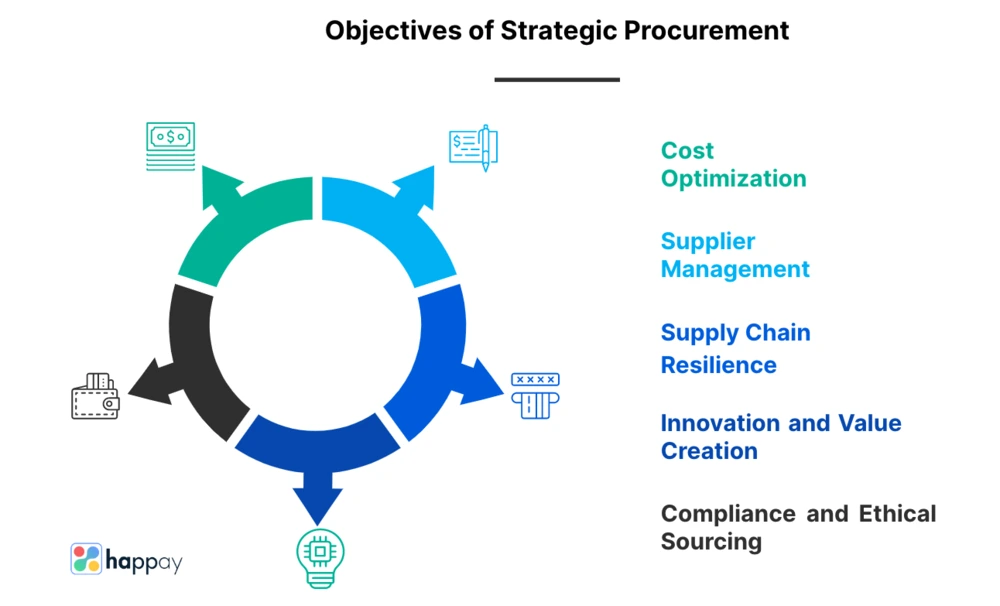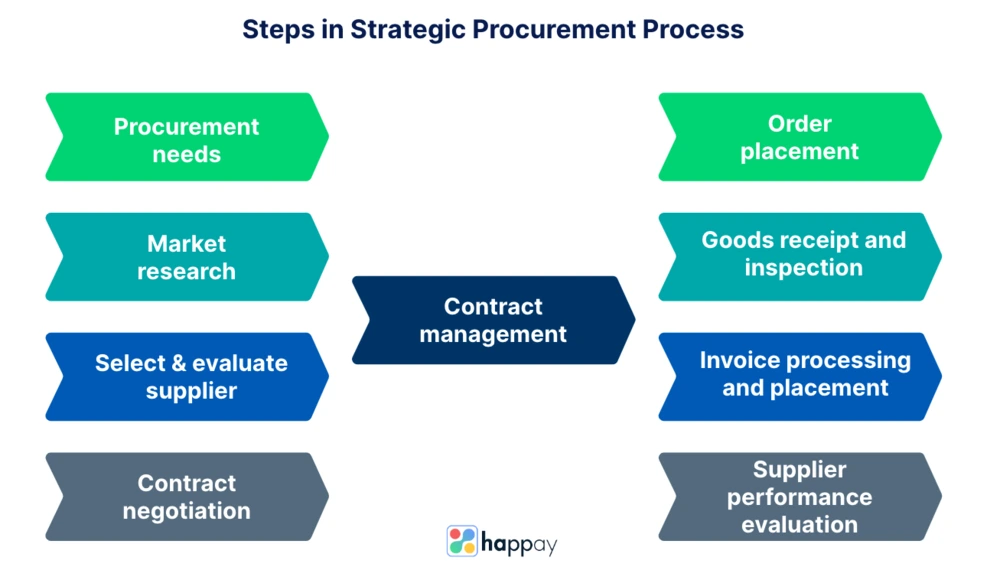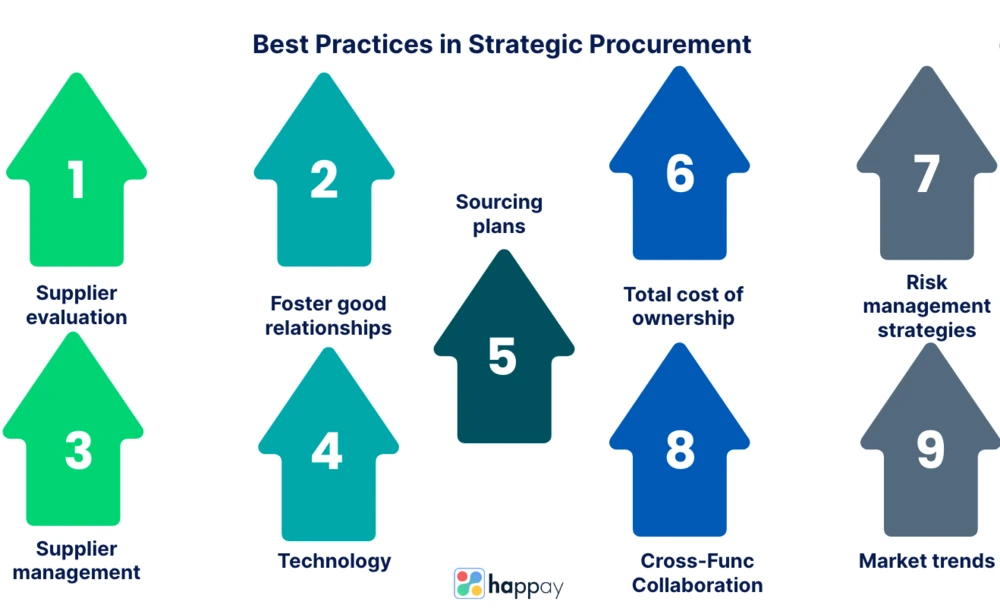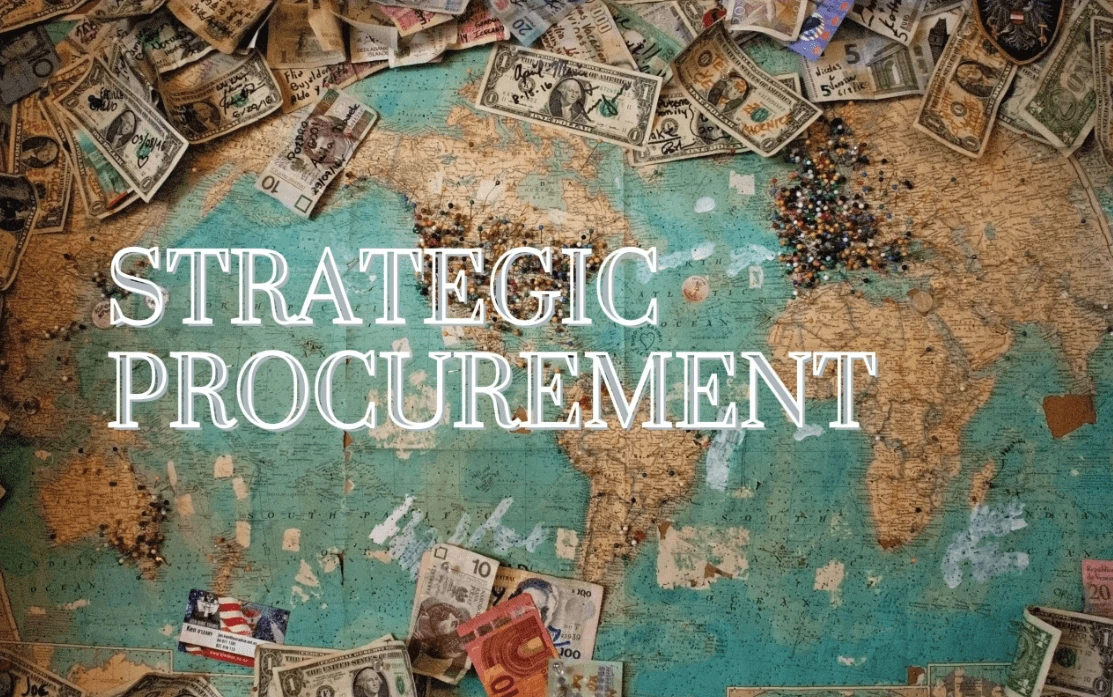Introduction to Strategic procurement
Strategic procurement as a concept has the potential to revolutionize the way your organization acquires goods and services. In the ever-competitive world of business, organizations can make it a differentiating factor to stay ahead of the competition.
While it may sound like another corporate buzzword, strategic procurement goes far beyond that. It is vital to unlock significant cost savings, foster supplier relationships, mitigate risks, and drive operational excellence.
Let’s understand how the strategic ways of procurement can optimize your supply chain for profitability and unlock new avenues for success.
What is strategic procurement?
Strategic procurement is a comprehensive approach to acquiring resources. It involves analyzing and aligning procurement functions with business goals and objectives. Factors like supplier market, contract negotiation, risk management, and performance evaluation are vital aspects of strategic procurement. Together, they aim to optimize the entire procurement process and achieve long-term value.
Furthermore, procuring strategically can drive cost savings, enhance supplier relationships, and ensure the availability of high-quality products and services. In essence, strategic means of procurement is a strategic mindset that empowers organizations to overcome inefficiencies and gain a competitive edge.
Importance of strategic procurement in modern business
Strategic procurement is a crucial driver of success for organizations, and its importance cannot be overstated. When organizations procure strategically, they can streamline their supply chains and enhance operational efficiency.
Adopting a strategic approach also helps them gain a competitive edge. Furthermore, they can mitigate risks through tactical forecasting and foster long-term partnerships. It ultimately empowers decision-makers to make informed decisions and achieve sustainable growth.
Benefits of strategic procurement
Here are some of the advantages of the strategic method of procurement for your company.
- Cost savings: Organizations can strategically identify suppliers, negotiate favorable contracts, and implement efficient procurement processes. It leads to cost reductions and optimization in spending patterns.
- Supplier relationship management: Procuring strategically is about building strong and mutually beneficial relationships with suppliers. Organizations can enhance collaboration and ensure the timely delivery of goods and services by actively managing supplier relationships. Strong relationships can also lead to preferential pricing.
- Risk mitigation: Another crucial advantage is mitigating supply chain disruptions and market volatility. Organizations can diversify the supplier base, conduct thorough risk assessments, and implement contingency plans.
- Improved quality and innovation: Besides cost savings, companies can also focus on the quality and innovation of goods and services by sourcing strategically. Organizations can ensure the availability of high-quality products and tap into supplier expertise to drive innovation.
- Enhanced operational efficiency: Companies can implement streamlined workflows, leverage technology solutions, and automate repetitive tasks by adopting a strategic sourcing process. It helps them free up valuable time and resources, allowing procurement professionals to focus on other value-added activities.
- Competitive advantage: Organizations prioritizing strategic sourcing are better equipped to respond to changing market conditions. They can adapt to customer demands and stay ahead of the competition to position themselves for sustainable growth.
Quick read: Source-to-pay (S2P): Meaning, Process, Steps and Benefits
What are the key principles of strategic procurement?
Here are some vital principles of the process:
- Alignment with organizational goals: Strategic procuring is grounded in aligning procurement activities with the overall business needs. It involves understanding the organization’s strategic direction and identifying opportunities to contribute to those goals.
- Total cost perspective: Procuring strategically goes beyond the initial purchase price. It considers the total cost of ownership, with an eye on maintenance, warranty, transportation, and disposal costs. Cost spectrum consideration allows organizations to make informed decisions that optimize value.
- Relationship management: This principle involves selecting competent suppliers and establishing collaborative partnerships. Organizations can work closely with suppliers to ensure a reliable supply chain.
- Risk management; Strategic sourcing focuses on conducting risk assessments and implementing mitigation strategies. Companies can minimize disruptions and protect their interests by addressing potential risks.
- Continuous improvement: It involves monitoring KPIs, analyzing procurement data, and identifying areas for optimization. Continuous refinement of procurement processes improves efficiencies and lays a foundation for cost reductions.
Here’s a quick read on: Purchase Order Process (PO) Guide: Meaning, Steps, Flowchart
What are the key objectives of strategic procurement?
Here are the key objectives of strategic procurement.

- Cost optimization: Optimizing costs throughout the procurement process includes negotiating favorable terms with suppliers and implementing cost-saving initiatives. The goal is to reduce costs while maintaining the desired quality and service levels.
- Supplier management: This objective involves supplier selection, performance evaluation, and collaborative engagement. Effective supplier or vendor management ensures timely delivery and quality assurance for competitive advantage.
- Supply chain resilience: Strategic procurement enhances supply chain resilience by mitigating risks and improving responsiveness. It involves identifying potential vulnerabilities, developing contingency plans, and diversifying the supplier base.
- Innovation and value creation: This objective involves engaging suppliers as strategic partners, leveraging their expertise, and exploring collaborative opportunities. Organizations can improve efficiency and gain a competitive edge by fostering innovation in the procurement process.
- Compliance and ethical sourcing: Strategic sourcing emphasizes ensuring compliance with legal, regulatory, and ethical standards. It involves implementing transparent and responsible procurement practices to promote sustainability throughout the supply chain.
Quick Read: 9 Best Vendor Payment Management Software
What is the strategic procurement cycle?
The strategic procurement cycle is a series of interconnected stages organizations follow to manage their procurement processes. It provides a structured framework to guide procurement activities from initial planning to supplier evaluation and contract management.
The key steps involved in the cycle include:
- Need assessment
- Supplier identification
- Supplier selection
- Contract negotiation
- Contract management
- Order placement
- Receipt and inspection
- Invoice processing and payment
- Supplier relationship management
- Performance evaluation
- Iterations and improvement
Read More: What is Procurement Life Cycle and their 15 Key Stages
What are the steps in the strategic procurement process?
Here are the ten steps involved in the process.

1. Identify procurement needs
The first step is to identify and define the organization’s procurement needs. It involves understanding the goods or services required, quantity, quality specifications, and more.
2. Conduct market research
The second step involves gathering information about potential suppliers, their capabilities, pricing, reputation, and other relevant factors. The goal is to create a pool of qualified suppliers for the procurement process.
3. Supplier evaluation and selection
Evaluating the potential suppliers includes cost, quality, reliability, capacity, past performance, and compliance with relevant regulations and standards. Organizations can shortlist suppliers that best meet their requirements through a systematic evaluation process.
4. Negotiate contracts
Once the suppliers are selected, the negotiation phase begins. There is a need to define the terms and conditions of the contract, including pricing, delivery schedules, and performance metrics. Effective negotiation ensures a mutually beneficial agreement between the organization and the supplier.
5. Contract management
Establishing an effective contract management system includes defining roles, ensuring compliance with contractual obligations, and monitoring supplier performance. Regular communication and performance reviews help maintain a strong supplier relationship.
6. Order placement
With contracts in place and suppliers selected, organizations proceed with placing orders for the required goods or services. This step involves generating purchase orders, specifying quantities, and delivery details.
7. Receipt and inspection
Upon delivery of the ordered goods or completion of services, it is essential to conduct thorough inspection and verification. This critical step ensures the received goods or services meet the organization’s quality standards.
8. Invoice processing and payment
After successful inspection, invoices are processed, and payments are made to suppliers according to the agreed-upon terms and conditions. Timely and accurate invoice processing is crucial for maintaining positive supplier relationships.
9. Supplier performance evaluation
Evaluating supplier performance involves monitoring and measuring supplier performance against predetermined key performance indicators (KPIs). The evaluation helps identify areas of improvement and provides feedback to suppliers.
Read More: Vendor Management System (VMS): Benefits, Features & TOP Systems
Examples of strategic procurement
Here are a few examples of strategic procurement that illustrate how it goes beyond traditional procurement practices by focusing on specific objectives.
1. Global supplier consolidation
One example of strategic procurement is when a multinational technology firm with operations in multiple countries decides to consolidate its global IT hardware suppliers. The company aims to achieve cost savings, improve supplier management, and enhance supply chain efficiency by streamlining the suppliers.
Consolidating its suppliers can help the company select a single vendor. It will help them negotiate volume discounts, standardize products, and optimize logistics. The end result will be reduced costs and improved service levels.
2. Sustainable sourcing and ethical procurement
With regard to sustainable sourcing and ethical procurement practices. organizations may choose suppliers that demonstrate environmentally friendly practices. They must also have fair labor conditions and ethical business conduct.
For instance, a clothing retailer may partner with suppliers that use organic cotton, implement renewable energy initiatives, and have fair trade and responsible manufacturing certifications. Incorporating sustainability and ethics into their procurement decisions will help them enhance their brand reputation and contribute to a more sustainable supply chain.
Quick read: What is Invoice Management: Types, Process, Systems, Challenges
How to implement your enhanced sourcing strategy at your organization?
Implementing an enhanced sourcing strategy requires careful planning and a systematic approach. Organizations can successfully implement it by following these steps.
1. Define objectives and goals
Determine what you aim to achieve. It could be cost reduction, supplier consolidation, improved quality, or sustainability. Align these goals with your business strategy to ensure coherence and relevance.
2. Conduct internal assessment
Assess your current sourcing processes, capabilities, and resources. Identify any gaps or areas for improvement during the implementation phase.
3. Develop a sourcing plan
Create a comprehensive sourcing plan with specific steps, timelines, and responsibilities. Consider supplier selection criteria, contract negotiation approaches, and risk management strategies.
4. Stakeholder engagement
Engage and communicate with key stakeholders, including procurement department heads and executives. Ensure their buy-in and support for the enhanced sourcing strategy. Collaborate with them to align their needs and expectations with the sourcing plan.
5. Supplier evaluation and selection
Develop a robust supplier evaluation process with quality, cost, reliability, and sustainability practices. Choose suppliers who can effectively support your organizational goals.
6. Negotiate contracts
Engage in contract negotiations with selected suppliers to establish mutually beneficial agreements. Effective negotiation ensures a fair and advantageous contract for both parties.
7. Implement supplier performance management
Establish a system for ongoing supplier performance management. Regularly evaluate their performance and address issues that arise promptly.
8. Monitor and evaluate
Track key metrics to assess the progress and effectiveness of your strategy. Identify areas of improvement and adjust your approach as needed to optimize outcomes.
9. Continuous improvement
Encourage feedback from stakeholders and suppliers, analyze data and insights, and implement process enhancements. Embrace innovation and stay updated with industry trends to drive ongoing optimization and adaptability.
10. Communication and training
Ensure that relevant procurement teams and stakeholders are informed about the enhanced sourcing process, its objectives, and the expected outcomes. Provide training and resources to equip employees with the necessary skills and knowledge to support the strategy.
Quick Read: How to Form a Successful Procurement Plan?
Best practices of strategic procurement
The strategic method of procurement encompasses the following practices aimed at optimizing procurement processes and driving value for organizations.

- Conduct effective supplier evaluation: Thoroughly evaluate potential suppliers based on quality, cost, reliability, and sustainability. Use a structured evaluation process to select suppliers that align with your organization’s strategic goals and requirements.
- Foster strong supplier relationships: Collaborate with them to foster open communication, share information, and align on objectives. Engage in regular meetings and performance reviews to strengthen the partnership and leverage supplier expertise for continuous improvement.
- Implement supplier performance management: Establish a robust supplier performance management system to monitor and measure supplier performance against predetermined metrics. Regularly assess their adherence to quality, delivery, and service level agreements.
- Embrace technology and automation: Implement e-procurement systems, supplier portals, and electronic document management. It will help improve efficiency, reduce manual errors, and enhance data visibility. Automation also allows for better data analysis and decision-making.
- Develop strategic sourcing plans: Analyze spending patterns, identify sourcing opportunities, and develop strategies for cost reduction, supplier consolidation, risk mitigation, and sustainability. Align sourcing plans with market trends, supplier capabilities, and industry best practices.
- Emphasize the total cost of ownership: Consider the total cost of ownership rather than focusing solely on the purchase price. Evaluate costs associated with maintenance, transportation, warranties, and disposal. Assessing it enables informed decision-making considering the long-term value and impact on the organization’s finances.
- Implement risk management strategies: Conduct risk assessments, establish contingency plans, and ensure business continuity. Diversify suppliers and have backup options to mitigate risks associated with supply chain disruptions.
- Encourage cross-functional collaboration: Involve stakeholders early in the procurement process to understand their needs, gain their support, and align procurement activities with their requirements. Cross-functional collaboration enhances procurement effectiveness and drives overall organizational success.
- Stay abreast of market trends and innovations: Stay updated on industry best practices, regulatory changes, and new sourcing opportunities. Embracing innovation and staying ahead of market developments can provide a competitive advantage.
Read more: Sourcing vs Procurement: A Complete Guide On Key Differences
Common challenges faced in strategic procurement implementation
Implementing strategic initiatives can be a complex endeavor that involves overcoming the following challenges:
- Resistance to change: Employees may be accustomed to established procurement processes and may resist adopting new strategies or technologies.
- Lack of executive support: Limited executive buy-in can result in inadequate resources, insufficient funding, and a lack of organizational commitment.
- Limited data and information: The strategic method of procurement relies on accurate and up-to-date data for informed decision-making. However, organizations may face challenges accessing comprehensive data on suppliers, spend management, and market trends. Incomplete or inaccurate data can hinder the development of effective supplier evaluation and overall procurement strategy.
- Supplier relationship management: Building and managing strong supplier relationships is crucial for success. However, challenges may arise in fostering effective communication, aligning expectations, and addressing issues promptly. Maintaining a balance between collaboration and assertiveness can be challenging, particularly when dealing with a large number of suppliers.
- Changing market conditions: Fluctuating prices, supply chain disruptions, or regulatory changes can present significant challenges.
- Talent and skills gap: A shortage of skilled procurement professionals with strategic thinking and analytical skills can impede successful implementation.
- Stakeholder alignment: Different departments may have conflicting priorities, making gaining consensus and support for the implementation plan challenging.
- Risk management: Organizations must identify and mitigate potential risks related to supplier performance, supply chain disruptions, compliance, and quality issues.
- Technology integration: Organizations may face challenges in implementing e-procurement platforms, supplier management systems, or analytics tools.
- Measuring success: Identifying relevant metrics, collecting data, and establishing benchmarks to assess successful implementation requires careful planning.
Quick Read: 10 Best Spend Management Software for Enterprises
Strategies and best practices for overcoming these challenges
Implementing strategic procurement initiatives requires the following best practices to overcome common challenges:
- Change management: Engage employees early, communicate the benefits, and provide training to facilitate a smooth transition. Involve key stakeholders and create a sense of ownership by involving them in decision-making.
- Executive support and sponsorship: Executives can advocate for the initiative, allocate necessary resources, and communicate its importance throughout the organization. Regularly update executives on progress, challenges, and achievements to maintain engagement.
- Data and information management: Implement procurement technology solutions like spend analytics tools and supplier management systems to gather and analyze data effectively. Regularly update and maintain data integrity to support informed decision-making.
- An agile and adaptive approach: Stay informed about industry trends, regulatory changes, and emerging technologies. Continuously assess and refine procurement strategies to remain competitive and capitalize on new opportunities.
- Talent development and skills enhancement: Provide opportunities for skill-building and the development of cross-functional learning. Encourage collaboration and knowledge sharing among team members to foster a culture of continuous improvement.
- Stakeholder engagement and alignment: Communicate the benefits of strategic procurement and how it supports the broader organizational goals. You can also consider involving stakeholders in planning to gain their approval and incorporate their perspectives.
- Robust risk management: Implement a robust risk management framework to identify, assess, and mitigate procurement-related risks. Develop contingency plans and alternative sourcing strategies to address potential disruptions.
- Technology integration and adoption: Develop a comprehensive technology integration plan that includes user training, change management, and ongoing support. Ensure that the chosen procurement technology solutions align with organizational needs and processes.
- Measurement and evaluation: Define relevant KPIs and establish a measurement framework to track the progress and effectiveness of strategic procurement initiatives. Regularly review performance against set targets and identify areas for improvement.
Technology and tools for strategic procurement
Here are the technology solutions and tools available to support organizations in their strategic procurement initiatives:
1. E-procurement platforms
E-procurement platforms provide a centralized system for managing requisitions, purchase orders, and supplier communications. These platforms streamline the procurement workflow and enable efficient collaboration between stakeholders.
2. Spend analytics tools
Spend analytics tools offer organizations valuable insights into their spending patterns and help identify opportunities for cost optimization. These tools analyze procurement data to identify spending trends and areas where consolidation or negotiation can be beneficial. They enable data-driven decision-making and support strategic sourcing initiatives.
3. Supplier management systems
Supplier management systems centralize supplier information, performance data, contracts, and communication in a single repository. These systems enable organizations to manage supplier relationships and streamline onboarding and evaluation processes.
4. Contract management software
Contract management software simplifies the creation, storage, and tracking of contracts. These tools provide a centralized repository for contracts, enable version control, automate contract workflows, and send alerts for renewal or termination dates.
5. Electronic auctions
Electronic auctions, also known as e-auctions or reverse auctions, enable organizations to obtain competitive bids from suppliers in real-time. These online bidding platforms promote price transparency and encourage suppliers to offer their best pricing. E-auctions can help source commodities or non-strategic items, resulting in cost savings and improved supplier negotiations.
6. Supplier performance monitoring tools
Supplier performance monitoring tools help organizations track and assess supplier performance against predefined metrics. These tools enable organizations to measure supplier quality, delivery, responsiveness, and adherence to contractual obligations.
7. Advanced analytics and predictive modeling
Advanced analytics and predictive modeling leverage data to generate insights and forecast scenarios. These tools can identify patterns, predict supplier performance, forecast demand, and optimize inventory levels.
8. Blockchain technology
Blockchain technology offers enhanced transparency and traceability in procurement processes. It enables secure and immutable record-keeping, eliminates the need for intermediaries, and improves supply chain visibility. Blockchain can be particularly valuable in industries where traceability and authenticity of goods are critical, such as pharmaceuticals or luxury goods.
Read More: What Is Spend Analytics in Procurement?
The role of digitalization in strategic procurement
Digitalization can revolutionize the field of strategic procurement, bringing about significant advancements and opportunities. Leveraging digital technologies helps organizations streamline procurement processes and enhance collaboration with suppliers. Digitalization enables the automation of purchase order generation, invoice processing, and supplier onboarding. It reduces errors and frees procurement professionals’ time for more strategic activities.
It also facilitates real-time data analysis, allowing organizations to make informed decisions based on -to-date information. Digital platforms and tools enable seamless communication and collaboration with suppliers, fostering stronger relationships and enabling better supplier performance management.
Read More: 10 Best Purchase Order Software
Best strategic procurement software for your organization
Selecting the best strategic procurement software is crucial to streamline procurement processes and achieve desired outcomes.
Some top strategic procurement software options to consider include:
- SAP Ariba
- SAP Fieldglass
- PRM360
- Coupa
- Workday
- RFP360
- Precoro
- Procurify
- Keelvar
- aPriori
Quick Read: TOP 10 Procurement Software Solutions
Future trends and outlook
The field of strategic procurement is continuously evolving, driven by emerging technologies and changing business dynamics. Here are some trends shaping the future of strategic methods of procurement:
Emerging Technologies Shaping the Future of Strategic Procurement
1. Artificial intelligence (AI) and machine learning
AI and machine learning are transforming procurement processes by automating tasks, improving data analysis, and enabling predictive insights. These technologies can optimize supplier selection, demand forecasting, contract management, and risk assessment, leading to more efficient decision-making.
2. Robotic process automation (RPA)
RPA streamlines manual and repetitive tasks like data entry and invoice processing. Organizations can enhance and improve overall procurement efficiency by automating these processes.
3. Internet of Things (IoT)
IoT devices offer real-time visibility into supply chain operations by collecting and transmitting data on inventory levels, product quality, and equipment performance. Leveraging IoT in strategic procurement enables proactive inventory management and enhanced supplier collaboration.
Predictions and insights into the evolving procurement landscape
1. Strategic supplier partnerships
Organizations will focus on building strategic partnerships with key suppliers to drive collaboration and sustainability. Deepening relationships with suppliers and jointly developing long-term strategies will be vital in gaining a competitive edge and mitigating supply chain risks.
2. Data-driven decision-making
As the importance of data continues to grow, procurement professionals will increasingly rely on advanced analytics and real-time insights to make informed decisions. Predictive analytics will enable proactive risk management and optimization of procurement strategies.
3. Sustainability and social responsibility
Supplier evaluation and selection will consider environmental and social criteria, promoting sustainable sourcing, ethical supply chains, and diversity and inclusion.
4. Agile and resilient supply chains
Organizations will prioritize building agile supply networks that can quickly adapt to disruptions and incorporate contingency plans. Supplier diversification, dual sourcing, and local sourcing strategies will gain prominence.
5. Continuous innovation and technology adoption
The adoption of emerging technologies and agile procurement processes will be critical to driving efficiency and maintaining a competitive edge.
Quick read: Order to Cash (O2C) Process: A Step-by-Step Approach
Bottom line
Strategic procurement is no longer a transactional function but a strategic imperative for organizations. By embracing innovation, leveraging technology, and adopting forward-thinking strategies, organizations can unlock the full potential of strategic sourcing and drive sustainable growth.
The procurement landscape will lay a greater emphasis on sustainability and agile supply chain management. Organizations that proactively embrace these trends and adapt their strategies will gain a competitive advantage and establish themselves as industry leaders.
FAQs
The role of procurement at a strategic level is to align procurement activities with the organization’s overall strategic objectives. The strategic method of procurement aims to optimize the value derived from the supply chain by aligning procurement decisions with long-term organizational goals.
The types of strategic procurement include direct procurement, indirect procurement, global sourcing, category management, supplier relationship management, and sustainable procurement.
The four elements of procurement strategy are sourcing, supplier selection, contract management, and performance measurement.
The seven stages of procurement are as follows:
1. Requirement identification
2. Supplier identification and selection
3. Negotiation and contracting
4. Order placement
5. Receipt and inspection of goods/services
6. Invoice verification and payment
7. Supplier performance evaluation and ongoing management.
Strategic procurement includes market research, supplier evaluation and selection, contract negotiation and management, demand forecasting, supplier relationship management, risk management, and performance measurement.
Operational procurement is the day-to-day transactional activities involved in acquiring goods and services. It includes requisition processing, purchase order creation, invoice processing, and supplier payment.
The main difference between strategic and operational procurement lies in their scope and focus. The strategic method is concerned with aligning procurement decisions with long-term organizational goals. Operational procurement, on the other hand, focuses on day-to-day transactional activities.
Traditional procurement is the conventional procurement approach emphasizing cost reduction and transactional efficiency. It often involves a reactive approach to procurement that involves selecting suppliers based on price and short-term considerations.
The difference between strategic and traditional procurement lies in their focus. The strategic method takes a proactive, long-term approach and considers factors beyond cost reduction. In contrast, traditional procurement focuses primarily on cost reduction and transactional efficiency, often taking a more short-term perspective.



Discussion about this post